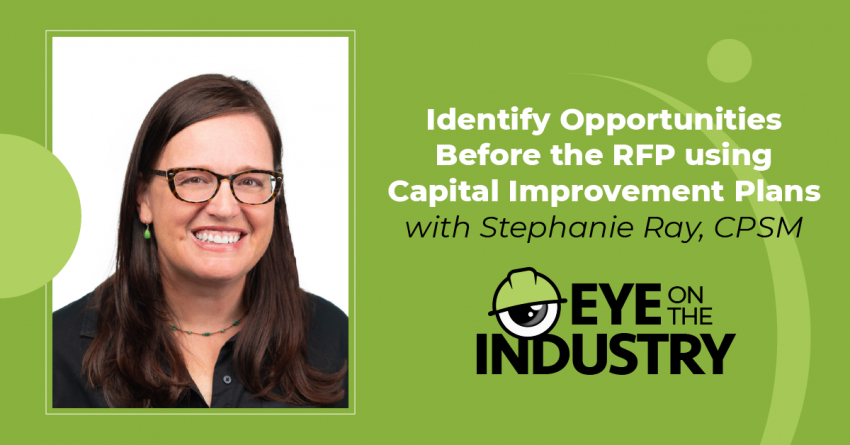How to Identify Public Opportunities before the RFP Stage
A Guide to Capital Improvement Plans
Strategic marketing research is critical in identifying opportunities before they reach the Request for Proposal (RFP) stage. Understanding how to identify public sector projects may seem like a daunting task for a marketer, but I have a major trick up my sleeve. Over my 25-year career, I have learned ways to utilize public resources like a capital improvement plan (CIP) to spot trends, discover leads, and develop realistic marketing plans—and you can use it too.
CIP Defined
A capital improvement plan is a working blueprint for community planning and fiscal management. The document is created by public entity (city, county, state, service district, etc.) and identifies improvement projects planned for a prescribed timeline.
Generally, there is a one-year list that is integrated with the entity’s annual operating budget and a multi-year list of expected capital projects. The CIP typically includes a description and justification of projects and can highlight specifics like location, cost, design and construction timeline, and funding source.
Know the Fiscal Year
When it comes to finding, reviewing, and extracting data, I recommend inding and utilizing CIPs right after they have been approved but before the fiscal year begins. Become aware of the general fiscal years for your key clients. Usually municipalities in a common area will have the same fiscal year but not always. Keep a record of which clients observe which fiscal year so you can do your research in a timely manner.
Obtain the CIP
Visiting the public entity’s website is the often best and easiest way to obtain the CIP. If a document is not available, Stephanie suggests looking for the approved budget, which will generally have a CIP section included.
If neither of these documents are available on the website, contact the specific department you are interested in working with (public works, transportation, recreation, water, sewer, engineering, etc.) or try the finance or administrative officer as they are typically responsible for publishing the budget.
What to Look For
Once you have a CIP in hand, what should a marketer look for? Hopefully you’ll find a ranked list of upcoming projects. If a detailed list is not available, look for budget line items for capital projects or improvements and then at the budgeted amount. Is the amount listed enough for the design and construction? If not, then chances are there are no projects planned for the coming year.
If possible, look for the entire life of the project. Have any funds already been spent on this project? Then it is likely the project is already in design. If the amount already spent is very small, then perhaps it hasn’t been awarded yet, but in most instances it means the project is already underway and there is no need to discuss it with the client. If you are uncertain, pick up the phone. It is better to ask than miss an opportunity.
And be aware that municipalities create budgets differently. Some will put all capital projects in one budget group, while others might put water capital projects in the water department, building capital projects under facilities, etc.
Three Ways to Avoid CIP Burnout
The task of gathering and reviewing CIPs can be time consuming and tiring. Here are some suggestions for collecting and analyzing data:
- Clear your calendar: Block out chunks of time to gather and review the documents. Break up your time and allow breaks between reviews so you don’t miss important information. Delegate and train junior staff, but make sure they understand what to look for so the needed information is not missed.
- Share the workload: Ask competent marketers from non-competing firms if they’re interested in sharing the work. Split up the CIP gathering and share information with each other. An architectural firm would likely be very happy, for instance, if a civil or mechanical subconsultant offered to help in researching upcoming projects.
- Outsource the work: If you simply don’t have the time to tackle the task, use a market research company like IMS. While it’s a more expensive solution, the public-sector research firm does the legwork for you by gathering CIPs from thousands of public agencies to identify customized lead results.
Identify Potential Projects
Armed with data, marketers can now begin to work with firm leadership to identify potential future projects and create a business development plan for which clients and projects they want to target.
Part of this plan should include meeting with the client to further discuss the upcoming projects to better position the firm for work. With upfront knowledge of the projects, technical staff can have informed discussions with the clients, helping them build necessary relationships.
While the work may not be fun, it is important. When technical staff responsibilities are stretched, a marketer can perform invaluable research that helps your firm accomplish its goals. By basing your strategic and marketing plans on data, you can achieve a competitive edge by positioning your firm for profitable work.






